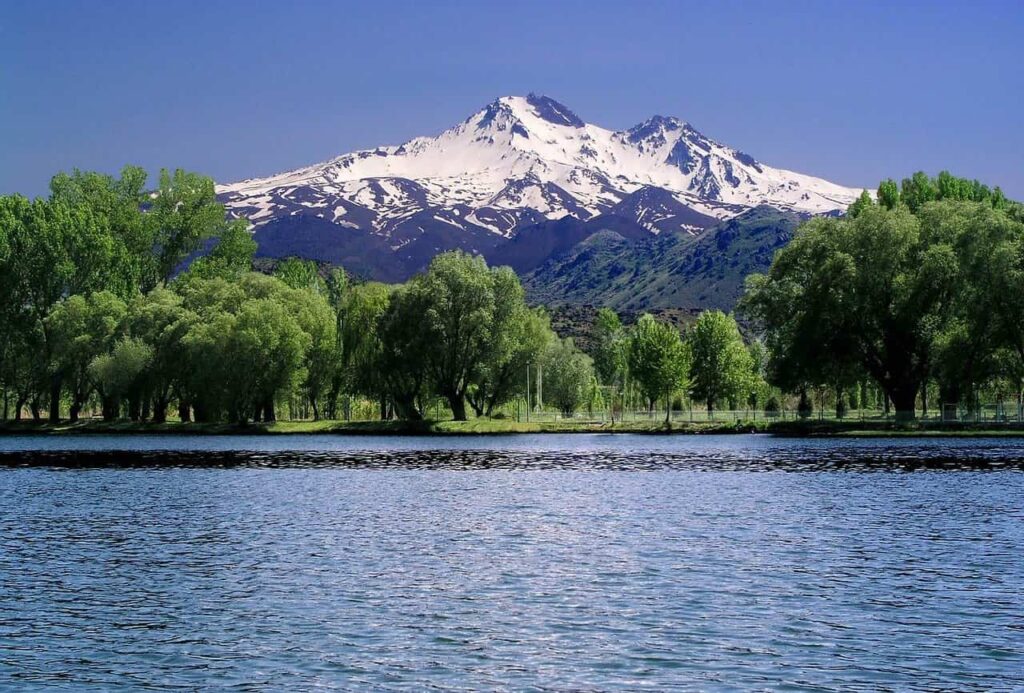Kayseri is the third largest city in the region after Ankara and Konya. Kayseri, where approximately 1.5 million people live, is located in the Central Anatolia Region of Turkey. Kayseri is one of the important industrial and commercial centers of the country. However, Kayseri has one of the most developed organized industrial zones in Turkey. Besides, Kayseri Free Trade Zone has the largest free zone area in Turkey. Kayseri’s industrial production capacity and diversity have also improved foreign trade. The city has a very important advantage in terms of culture, nature and winter tourism. It is home to one of the country’s most important facilities for ski tourism. In addition, there are many historical places belonging to various civilizations in Kayseri that can be visited.
Agriculture, industry, trade and transportation sectors come after the economy of Kayseri. Most of the agricultural land is reserved for grain cultivation. Kayseri is a province that can be considered rich in mineral assets such as gold, copper, lead, zinc and iron. The city also has great potential in renewable energy sources such as solar and wind. Kayseri is one of the cities with the highest renewable energy investment in Turkey.
In terms of education, Kayseri has one of the highest quality universities in the country, like Erciyes University. Kayseri Airport is 10 km away from the city center and you can find many direct and connecting international flights to different cities and countries of the world.
Let’s not forget the food lovers, Kayseri lubrication and never return without eating Kayseri ravioli.
Now come on “How to go to Cappadocia from Kayseri?” Let’s look at the rest of my article, where you can find answers to your questions such as “Places to Visit in Kayseri“.
How to Get From Kayseri to Cappadocia?
Kayseri Erkilet Airport is located in Kayseri, about 80 kilometers east of the villages located at the center of Cappadocia’s tourism sector. The much smaller Nevşehir Kapadokya Airport is located just north of Gülşehir district, approximately 40 kilometers northwest of the villages.
Pre-booked airport shuttles run door-to-door from both airports to hotels in Cappadocia. It offers transportation service. The journey time from Kayseri Airport may take up to 2 hours depending on both the waiting time for all passengers who book the shuttle service and the region you are staying in. Shuttle buses from Nevşehir Airport do not take more than 30 minutes.
Where to Stay in Kayseri?
In addition to having various hotels in Kayseri, there is also a Tinyhouse accommodation.. Becen Winter House, Kayseri’s first and only Tinyhouse accommodation. I also had the chance to stay for 1 night when I went.. 2 tinyhouses side by side in a garden in the Becen Bağları district of Kayseri’s Melikgazi district.. Tinyhouses are 10 minutes away from Mount Erciyes by car.. There is also a villa in the garden that you can choose for accommodation.. Villa could be better for large teams. But if you say that tinyhouse accommodation is also a pleasure, I recommend these 24 square meters houses on wheels, like me..
One of the tinyhouses can accommodate up to 3 people, while the other one can accommodate up to 4 people.. Both have kitchen and bathroom needs.. Breakfast services are also available for an extra fee.. By the way, let me talk about the following detail, Becen House manufactures and sells these tiny wheelhouses, keep in mind..
Places to Visit in Kayseri
Kayseri Castle
The monumental black basalt walls of Kayseri Castle were first built by the Roman Emperor III.. The imposing structure you see today is often. It is the work of the 17th century Seljuk sultan Alaaddin Keykubat.
The outer walls descend to Park and Talas Streets.. At the time of the research, a massive restoration project was underway in the citadel, scheduled to be completed in mid-2020.
When the restoration is complete, the interior will be the new home of the Kayseri Archaeological Museum and will provide space for an arts centre.
Güpgüoğlu Mansion
Building 15. It dates from the 19th century and the influence of Mamluk architecture is evident in its black-and-white stone façade.. 19. With its colorful beams and intricately carved woodwork in the 19th century, the house was home to composer and lyricist Ahmet Mithat Güpgüpoğlu.
Kayseri Archeology Museum
Kayseri’s small archaeological museum, located in nearby Kültepe’ It is a small magpie nest containing finds from den (the main city of the Hatti people and the first Hittite capital).. Other exhibits include a stunning sarcophagus depicting the labors of Hercules, and a fascinatingly spooky display of child mummies.
Surup Krikor Church
Church of Surup Krikor Illuminator from the century, the rest of Anatolia one of the few Armenian churches. Its domed interior, complete with dilapidated frescoes and three gilded altars, offers a glimpse into the importance of Kayseri’s once vibrant Armenian community.. For the entrance, turn around the back wall of the church, ring the bell and the guard, one of the five remaining Armenians in the city, will let you in.. The church is located off Osman Kavuncu Boulevard, 2 kilometers downstream from Necip Fazıl Boulevard.
Seljuk Civilization Museum
This excellent museum is located in the Seljuk sultan I.. It was built on the will of Keyhüsrev and his sister Gevher Nesibe Sultan.. It is located in the restored Çifte Madrasa, a twin hospital and clergy dating from the 19th century.. It is thought to be one of the world’s first medical training schools. The stunningly serene architecture is balanced by beautiful exhibits of Seljuk art, culture and history and complemented by the latest multimedia screens.. Our only complaint is the lack of English translations of the information panels.
Mahperi Hunat Hatun Complex
Simple and magnificent Mahperi Hunat Hatun complex, 13. It is one of the most beautiful Seljuk monuments in Kayseri, built in the 16th century during the reign of Sultan Alaattin Keykubat.. It includes the Hunat Hatun Madrasa, with its famous shaded courtyard that will now be used as a cafe, with student cells surrounding various artisan shops, the Mahperi Hunat Hatun Mosque (Mosque), and the still functioning hamam.
Lake and Waterfalls in Kayseri
Kapuzbaşı Yahyalı Waterfalls, 70 km south of Kayseri, empties into Zamantı river and finally Seyhan, with seven different levels varying in height from 30 to 50 meters. This series of waterfalls, which is one of the most important waterfalls in the world in terms of flow rates and heights, is almost a natural phenomenon.
Kayseri Great Mosque
The Great Mosque in Kayseri was started by Danishmend Turkish orders in 1142. and was finished by the Seljuks in 1205.. Despite all the ‘restoration’ over the centuries, it is still a good example of the early Seljuk style.
Sahabiye Madrasa
Sahabiye Madrasa dates from 1268. Today, its courtyard is a cafe with rooms around it used as a bookstore.. Its door, which is richly decorated with muqarnas details, is particularly striking.
Ahi Evran Zaviye
For craftsmen and artisans 13. The bleak interior of this turn-of-the-century techie is great for walking around. From calligraphy to metalwork and farm tools to carpet looms, dusty exhibits are filled with a jumble of sales-style delight.. It is 1 kilometer down from Talas Street, across from the cemetery.
Kayseri Thermal Springs
The Bayramhacı Thermal Spring, located 65 km west of Kayseri, has 55 rooms and 140 beds, for two men and two women. There is a pool. The water is between 38ºC and 40ºC and is good for the treatment of rheumatism, skin, heart and blood circulation, respiratory system and gynecological diseases.
33 km from Kayseri.. The temperature of Tekgöz Thermal Springs, which has a pool for men and women in the district of Yem İsliha, is 43ºC. The waters here are said to treat rheumatism, skin, respiratory system, kidney and urinary tract, and gynecological diseases.
Traveling in the Kervansaray in Kayseri
Sultan Caravanserai, located 50 km northeast of Kayseri, Seljuk Sultan I. Alaattin I. It was built by Keykubat between 1232-1236.. Its most beautiful features are the door decorations and interior architecture, especially the intricate snake motif on it.. mosque arches. It is the second largest caravanserai in Anatolia and has been beautifully restored.
The Karatay Caravanserai, located in the village of Karadayı, was built in 1255 by Celalettin Karatay, one of the Seljuk viziers. The reliefs and columns on the tomb are good examples of Seljuk stonework. Inside the left portal is an unmarked tomb decorated with animal figures, and the ceiling inside the tomb was painted blue to mimic the sky.
The Kara Mustafa Pasha Caravanserai was part of a new town built for Emir Kara Mustafa Pasha in 1667 and was one of his vizier. There is also a mosque and a bath, a madrasah and a bazaar with 30 shops in the complex.. There is a fountain in the middle of the courtyard, which attracts attention with its interesting architecture. Wool and raw cotton carpets are sold on the ground floor, and Kayseri carpets are sold on the upper floor.
The covered bazaar is a ceiling cover consisting of three domes and a cupola. It was built in 1497.
Grand Bazaar One of Turkey’s four largest covered bazaars and with four entrance gates, Kayseri was built by the people in 1859.
Let’s not see Kayseri.. In this article, I shared information about places to visit in Kayseri.. Lots of discoveries…







